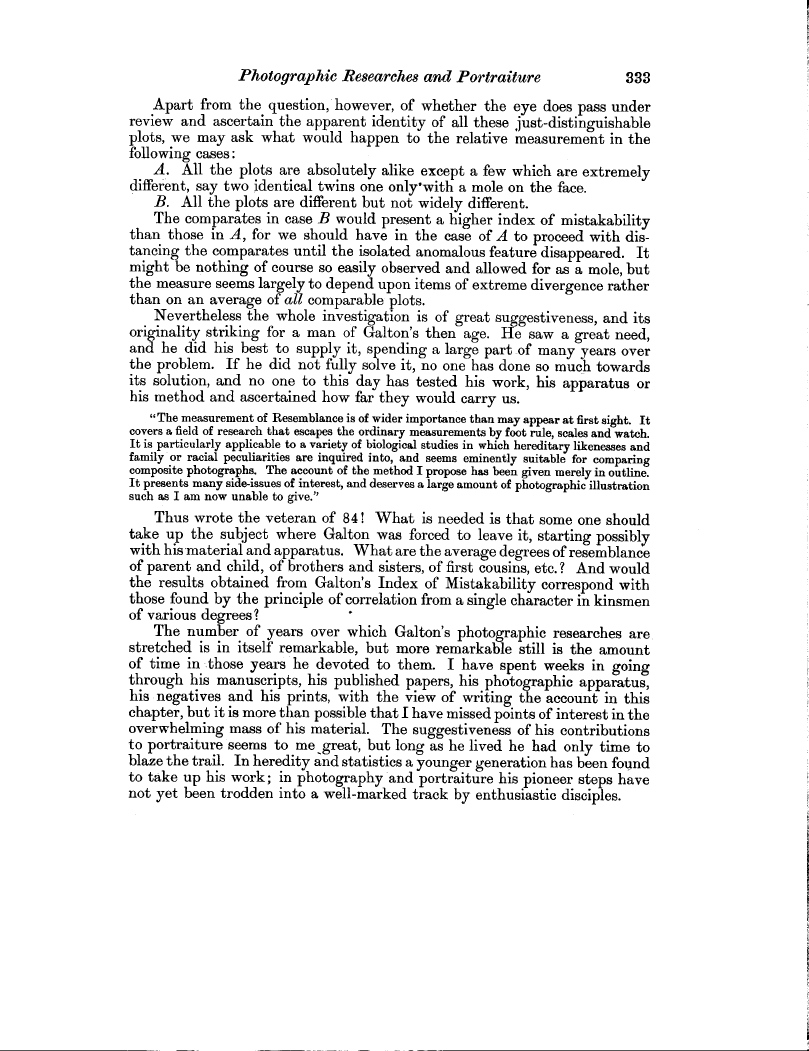Photographic Researches and Portraiture 333
Apart from the question, however, of whether the eye does pass under review and ascertain the apparent identity of all these ,just-distinguishable plots, we may ask what would happen to the relative measurement in the following cases
A. All the plots are absolutely alike except a few which are extremely different, say two identical twins one only'with a mole on the face.
B. All the plots are different but not widely different.
The comparates in case B would present a higher index of mistakability than those in A, for we should have in the case of A to proceed with distancing the comparates until the isolated anomalous feature disappeared. It might be nothing of course so easily observed and allowed for as a mole, but the measure seems largely to depend upon items of extreme divergence rather than on an average of all comparable plots.
Nevertheless the whole investigation is of great suggestiveness, and its originality striking for a man of Galton's then age. He saw a great need, and he did his best to supply it, spending a large part of many years over the problem. If he did not fully solve it, no one has done so much towards its solution, and no one to this day has tested his work, his apparatus or his method and ascertained how far they would carry us.
"The measurement of Resemblance is of wider importance than may appear at first sight. It covers a field of research that escapes the ordinary measurements by foot rule, scales and watch. It is particularly applicable to a variety of biological studies in which hereditary likenesses and
family or racial peculiarities are inquired into, and seems eminently suitable for comparing composite photographs. The account of the method I propose has been given merely in outline. It presents many side-issues of interest, and deserves a large amount of photographic illustration
such as I am now unable to give."
Thus wrote the veteran of 84! What is needed is that some one should take up the subject where Galton was forced to leave it, starting possibly with his material and apparatus. What are the average degrees of resemblance of parent and child, of brothers and sisters, of first cousins, etc. ? And would the results obtained from Galtori s Index of Mistakability correspond with those found by the principle of correlation from a single character in kinsmen of various degrees?
The number of years over which Galton's photographic researches are stretched is in itself remarkable, but more remarkable still is the amount of time in those years he devoted to them. I have spent weeks in going through his manuscripts, his published papers, his photographic apparatus, his negatives and his prints, with the view of writing the account in this chapter, but it is more than possible that I have missed points of interest in the overwhelming mass of his material. The suggestiveness of his contributions to portraiture seems to me ,great, but long as he lived he had only time to blaze the trail. In heredity and statistics a younger generation has been found to take up his work; in photography and portraiture his pioneer steps have not yet been trodden into a well-marked track by enthusiastic disciples.

